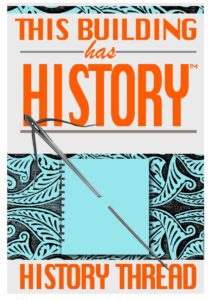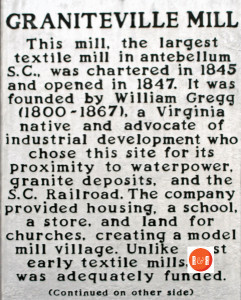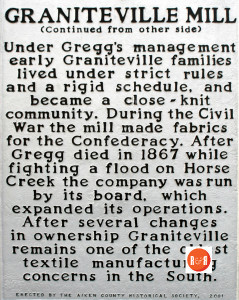The Yorkville Enquirer of Aug. 24, 1882 reported – “The Vaucluse Mills of the Graniteville Manufacturing Company are working on an order from San Francisco for 300,000 yards of goods and 150,000 bags.”
The Yorkville Enquirer reported on Sept. 27, 1883 – “The cotton mill at Vaucluse in Aiken Co., is consuming 75 bales of cotton weekly.”
City Directories and History: Vaucluse historic district includes the Vaucluse mill compound, located in the center of the village; a ca. 1904 three-building commercial complex located just north of the mill compound; a company built swimming pavilion; the 1877 mill dam; the Vaucluse mill pond; and 83 former company dwellings located in parallel rows along five of the villages residential streets that extend in a rough spoke fashion from the mill compound. The general character of the historic district is a combination of industrial, commercial, and residential use. The Vaucluse mill dominates all other structures in the village; the mill compound includes an 1877 boiler house and smokestack, seven brick hose houses, a 1939 office building, and a 1943 employee canteen. The textile mill village at Vaucluse is an excellent example of a southern textile mill village. It is the oldest mill village in the state, with textile production commencing there around 1830. Contextually, it relates to the birth, rise and decline of the textile industry in South Carolina. In addition, Vaucluse represents the social changes brought about by the spread of mill villages in the state, with the development of the mill worker population created by the expansion of the textile industry. Vaucluse was also the site of William Gregg’s first foray into textile production, with many historians considering Gregg to be the father of the textile industry in the South. The 1877 mill building was also one of the earliest efforts of architect Amos Lockwood, whose subsequent firm, Lockwood and Greene, would go on to design 50 textile manufacturing facilities in South Carolina. Lockwood’s factory design at Vaucluse was of the earliest examples of the New England prototype mill to be built in South Carolina. Listed in the National Register May 7, 1996.
Stay Connected
Explore history, houses, and stories across S.C. Your membership provides you with updates on regional topics, information on historic research, preservation, and monthly feature articles. But remember R&R wants to hear from you and assist in preserving your own family genealogy and memorabilia.
Visit the Southern Queries – Forum to receive assistance in answering questions, discuss genealogy, and enjoy exploring preservation topics with other members. Also listed are several history and genealogical researchers for hire.
User comments welcome — post at the bottom of this page.
Please enjoy this structure and all those listed in Roots and Recall. But remember each is private property. So view them from a distance or from a public area such as the sidewalk or public road.
Do you have information to share and preserve? Family, school, church, or other older photos and stories are welcome. Send them digitally through the “Share Your Story” link, so they too might be posted on Roots and Recall.
Thanks!



